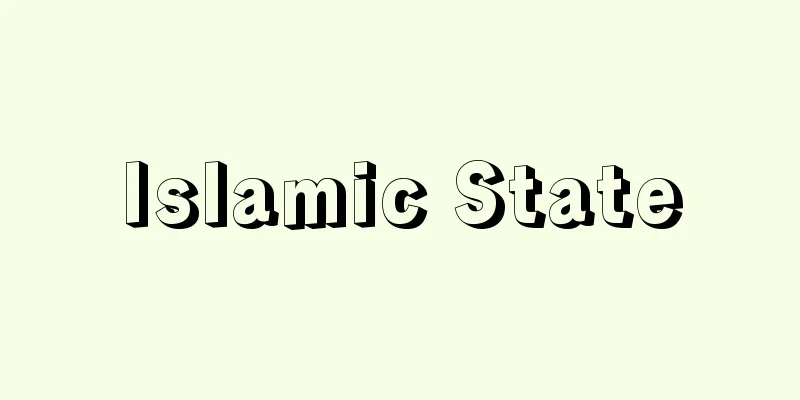Calligraphy - Calligraphy

|
A formal code of etiquette that stipulates the format and terminology of letters. It arose from the idea of emphasizing etiquette based on the status of the two people exchanging letters. There are two types: for nobles (Kugeyo) and for samurai (Buke). Originally, it was based on the Chinese "Shogi" (Calligraphy), but in the late Heian period, official documents declined, and with the development of private documents and the study of court etiquette, collections of model letters such as "Meigou Orai" were created, while books on letter etiquette for nobles were also written. It was established in 1285 (Kōan 8) by Ichijō Ietsune and others in the "Kōan Reisetsu" (Kōan Etiquette). This book stipulated etiquette for those in the imperial court, but it also included a section on letter etiquette, which became the basis for later letter etiquette. The samurai's calligraphy and decorations were derived from those of the nobility, and were apparently already in place by the end of the Kamakura period. In the Muromachi period, it was established around the time of the third shogun, Ashikaga Yoshimitsu, and the samurai became the center of calligraphy and decorations. At the same time, the power of the yūhitsu, who were professional writers, grew stronger, and each family began to teach their own style of calligraphy and decorations. Representative examples include the early "Imagawa Ryōshun Calligraphy and Decorations," and the later "Hosokawa Family Calligraphy and Decorations," "Odate Tsuneoki Calligraphy and Decorations," and "Sōgo Ozoushi." After that, the samurai's calligraphy and decorations spread to the provinces, and the feudal lords of the Sengoku period also adopted it and established their own calligraphy and decorations. The same was true under the Azuchi-Momoyama government, which maintained the system with some modifications, and the Edo Shogunate also had the system established by Tokugawa Ieyasu under the orders of Nagai Naokatsu during the Keicho era (1596-1615), and it continued throughout the Edo period. [Miki Ebisawa] "The History of Letters by Shigemi Komatsu (Iwanami Shinsho)" [Reference] | |Source: Shogakukan Encyclopedia Nipponica About Encyclopedia Nipponica Information | Legend |
|
書状の形式・用語などを規定した礼法式。手紙を取り交わす両者の身分的相違による礼儀を重視しようという考えから生じたもの。公家様(くげよう)と武家様の二様ある。元来は中国の『書儀(しょぎ)』などによっていたが、平安後期には公式様(くしきよう)文書が衰退し、私(し)文書の発達や有職故実(ゆうそくこじつ)学の発展に伴って、『明衡往来(めいごうおうらい)』などの書状の模範例文集がつくられるようになる一方、公家様の書札礼の書も著されてきた。それが確立されたのは1285年(弘安8)に一条家経(いえつね)らによって編まれた『弘安礼節(こうあんれいせつ)』によってである。この書は宮廷関係の礼節を定めたものであったが、書札礼について一項を設け、それが後の書札礼の典拠となった。武家様の書札礼は、公家様から派生したものであり、鎌倉末にはすでにできあがっていたらしい。室町時代になると3代将軍足利義満(あしかがよしみつ)のころに整備され、武家様が書札礼の中心となった。それとともに文章作成を職業とする右筆(ゆうひつ)の力が強くなり、各家がそれぞれの流儀による書札礼を伝授するようになった。初期の『今川了俊(いまがわりょうしゅん)書札礼』や後期の『細川家(ほそかわけ)書札抄』『大館常興(おおだてつねおき)書札抄』『宗五大草紙(そうごおおぞうし)』などが代表的なものである。以後、武家様の書札礼は地方に波及し、戦国大名諸家もそれを受容し、自らの書札礼を定めていった。織豊(しょくほう)政権下でも同様で、多少の改変はあったが維持され、江戸幕府も徳川家康が慶長(けいちょう)年間(1596~1615)に永井直勝(なおかつ)に命じて制定させたものが江戸時代を通じて行われた。 [海老澤美基] 『小松茂美著『手紙の歴史』(岩波新書)』 [参照項目] | |出典 小学館 日本大百科全書(ニッポニカ)日本大百科全書(ニッポニカ)について 情報 | 凡例 |
Recommend
Geinichiwan - Geinichiwan
A bay located on the coast (Sea of Japan side) ...
Neocaridina denticulata (English spelling)
…It is similar in morphology to the common freshw...
Family festival - Uji Festival
…It is noteworthy that in the original ujigami ri...
Dis
…His name means “the invisible one.” In Roman myt...
Antimony flower - Antimony flower
…Antimony minerals include stibnite (Sb 2 S 3 ) ,...
Issei Ichigen (English spelling) Yi-shi yi-yuan; I-shih i-yüan
A system in which one era name is used for each re...
Emergency - a state of emergency
A state in which there is an immediate danger to ...
Ch'oe Mu‐sŏn (English spelling)
?‐1395 Inventor of gunpowder in the late Goryeo Dy...
Te-nashi - Hospitality
This is the most primitive form of Japanese clothi...
Madinat Habu (English spelling)
…In front of this inner sanctuary are a hypostyle...
VAR - Virtual Reality
Video assistant referee : In soccer, a referee who...
Kam-Tai - Kam-Tai
...However, for example, today's hunter-gathe...
Tomé de Sousa
?-1579 The first governor of the Portuguese colony...
Igaito
...The word "Kakiuchi" appears in docum...
Legend of the Golden Rooster
There is a legend that a golden rooster is buried...









